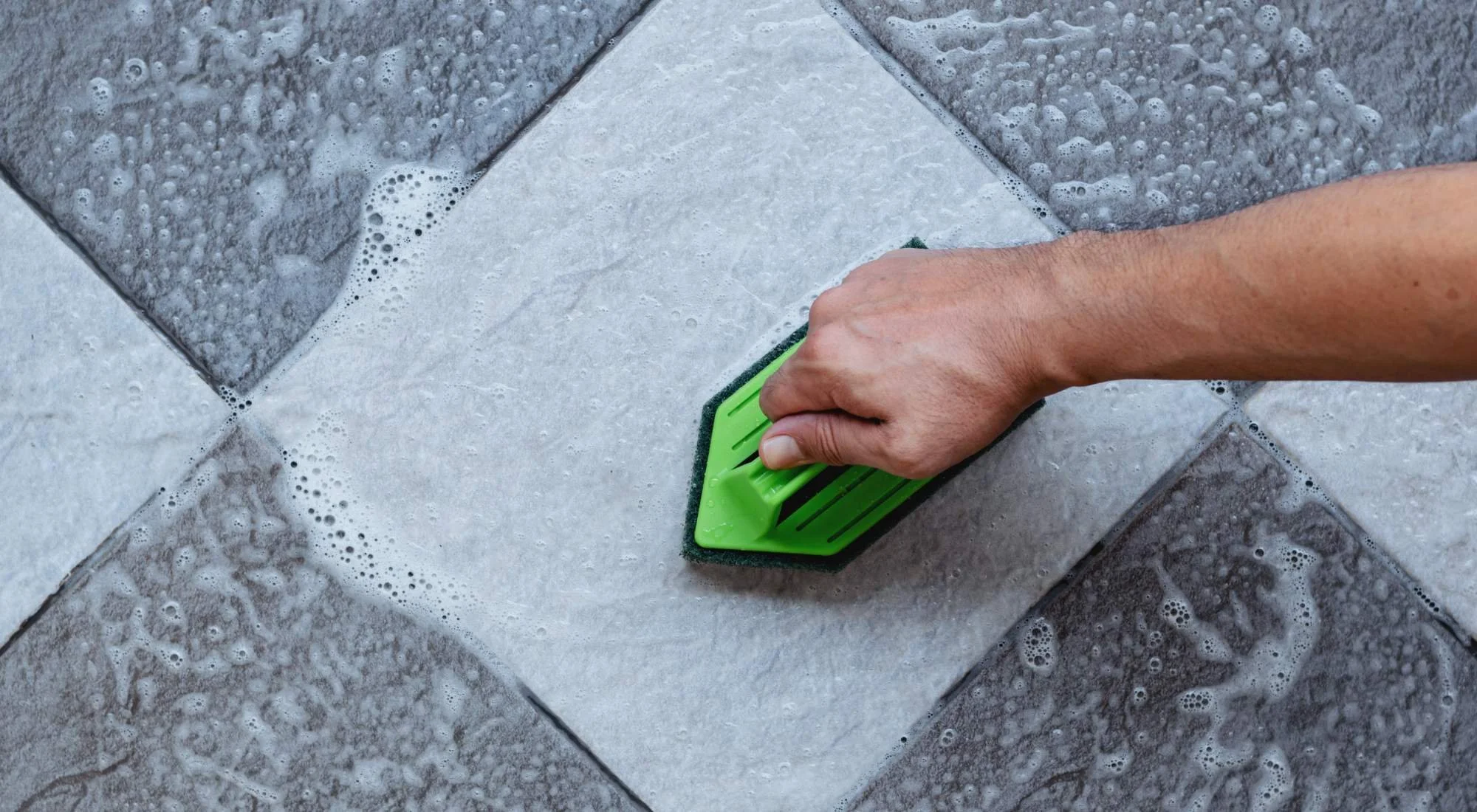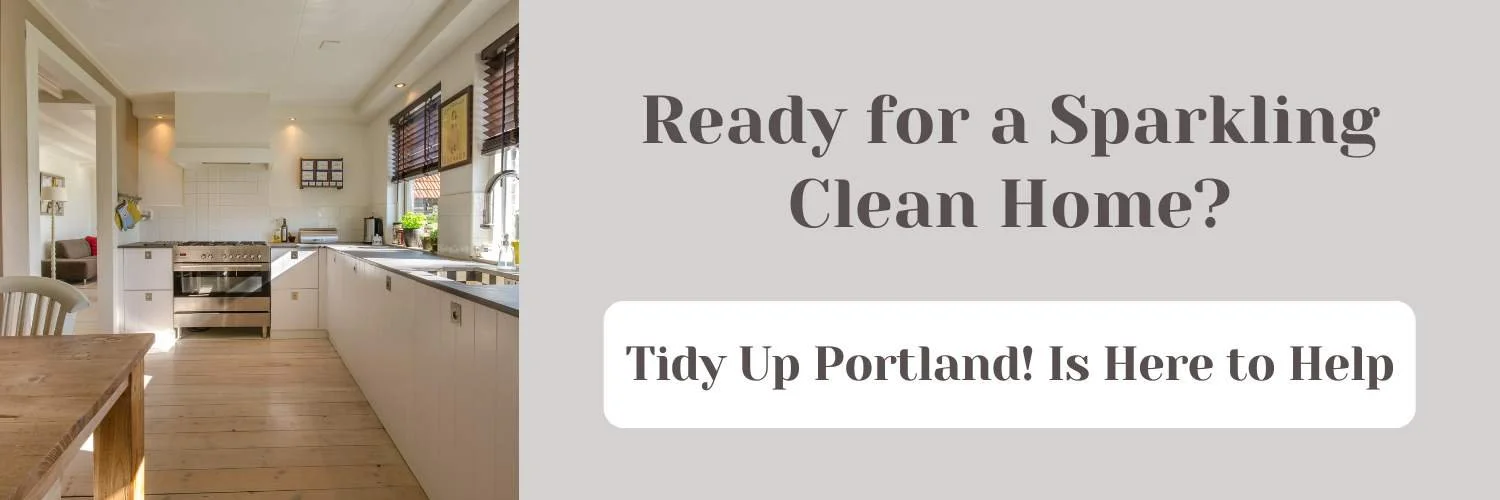Tile and Error: Mastering the Art of Sparkling Tile Floors
You spent most of yesterday cleaning house, and now you’re basking in the fresh scent, sparkly mirrors, and vacuum lines on the carpet.
But like always, there’s just one thing keeping you from experiencing spotless perfection — your tile floors.
While you love the durability of tile flooring, it doesn’t seem you can ever quite get it to the same level of cleanness as the rest of your home.
Is there a secret? What’s the best floor cleaner for tile floors?
At Tidy Up Portland! we’re savvy to the mystique of cleaning tile floors. From ceramic to vinyl to grout, our team of professional house cleaners unveils the best tile floor cleaners and methods to get your floors top-level clean.
Table of Contents
Gathering the Supplies Needed for Cleaning Tile Floors
It’s always easier to tackle a job when you have all your supplies in one place. Supplies you might need for cleaning tile floors include:
Bucket
Mop
Brushes
Steam mop
Cleaning products
Vacuum
Want to save yourself the hassle and mess of cleaning tile floors on your own? Tidy Up Portland! is happy to help! We have cleaning packages to suit every need and will even do a virtual walkthrough to get to know you and your home.
Reach out today to learn more.
Cleaning Recommendations Based on Tile Type
Cleaning tile floors isn’t a universal process. To maintain the look and longevity of your floors, choose the best cleaning method for your particular type of tile.
How To Clean Ceramic and Porcelain Tile Floors
Ceramic and porcelain tile floors are known for their durability, and with a few quick steps, you can keep them sparkling for years to come:
Get rid of loose debris: Vacuum or sweep your floors regularly. Ceramic and porcelain tiles are resistant to dirt, but grit and sand can easily dull the glazed surfaces.
Use the right floor mop: Choose a chamois-type mop or rag (rather than a sponge mop). Sponge mops just push dirty water into the grout lines, making them harder to clean.
Choose the right cleaner. The best floor cleaner for tiles made of ceramic and porcelain is water and a mild detergent.
Be on the lookout for stains: If you find discoloration on your tile, try to determine the cause, then use the appropriate cleaner for the stain.
Watch for soap residue: If your ceramic or porcelain tile appears hazy after cleaning, it might be due to soap residue. Remove the soapy film with a nonabrasive all-purpose cleaner or a homemade cleaner with a mild acid like fresh lemon juice.
Dry the floor: Don't allow your porcelain or ceramic tile floors to air dry, since standing water will turn into water spots. Dry the floors with a clean, lint-free cloth as soon as you’re done cleaning.
How To Clean Stone Tile Floors
These types of tile floors require a different approach than ceramic and porcelain since the harsh substances found in traditional cleaners can easily damage the surface:
Slate tile: You can use a mild detergent on slate tiles, as long as it’s free from acids like lemon or vinegar. If your slate tile flooring is coated, dry the tile immediately after cleaning to avoid water spots.
Marble tile: Marble tile flooring is stunning, but high maintenance. Avoid cleaning marble tiles with lemon or vinegar, as they can etch the tile's surface. For marble, you’ll also want to skip using anything that may scratch the stone, including brushes with tough bristles or scouring powders.
Granite tile: Clean granite tile with a mild pH-neutral detergent. If your granite floor is polished, buff it to keep it looking shiny and clean.
How To Clean Resilient Tile Floors
Resilient tile floors include:
Linoleum tile: Begin by sweeping or vacuuming. Then wash the tile with borax detergent and water or linoleum flooring cleaning solution. Rinse the floor, then allow it to air dry. To add an extra layer of protection to linoleum floors, apply a coat of wax or liquid wax and buff to a shine every 3 to 6 months.
Vinyl tile: Not only is vinyl ultra-resilient, but it’s also easy to maintain. Simply vacuum or sweep up dirt and debris, then mop with water and vinegar or vinyl cleaning solution. Skip the abrasive cleaners or scrubbing tools on vinyl to avoid scratching the surface.
Cork tile: The best method of cleaning tile floors made of cork varies based on the tile’s finish. If the cork has been sealed with polyurethane, as most cork floors are, clean the surface with water and mild detergent or white vinegar, then rinse thoroughly. If your cork tile is waxed or unfinished, follow the cleaning procedure for polyurethane but add a coat of solid or liquid wax once the tile is fully dry.
How To Clean Grout
The key to a spotless-looking tile floor is clean grout.
Grout comes in several varieties and requires specific cleaning procedures, depending on the type of grout:
Sanded grout is slightly porous but durable. Use a steam mop for general cleaning and target stains with a brush or handheld steam cleaner. Strong chemicals can erode the sanded grout and should be avoided.
For sanded grout, you may also follow this procedure:
Make a DIY grout cleaner: Skip the commercial cleaners and make an easy, economical paste of baking soda and water.
Scrub: Rub the paste on the grout and allow it to sit overnight. The next day, scrub the grout with a stiff nylon brush, repeating the process as necessary.
Seal: Once the grout is clean and dry, apply a silicone-based sealer to repel future dirt and stains. Sealant is best applied 10–14 days after the grout has been cleaned or installed.
Unsanded grout is durable and frequently used with tile that is prone to scratching. A steam mop is the choice for regular cleaning, along with a handheld steam cleaner or soft-bristled brush for eliminating stains. Aggressive scrubbing or acidic cleaners are not recommended for unsanded grout.
Epoxy grout is often the ideal choice for high-moisture areas due to its stain resistance. Use a steam mop to clean the surface and a brush or handheld steam cleaner to target stains. Abrasive scrubbing pads can dull epoxy’s finish and should not be used.
Common FAQs About Cleaning Tile Floors
How Do You Know When Your Tile Floors Need To Be Cleaned?
Signs that it might be time to clean tile floors include:
Obvious dirt
Dingy grout
Film on the tile
How Often Should You Clean Your Tile Floors?
The frequency of cleaning tile floors depends on various factors, including:
The type of tile
The amount of traffic
The location of the tile (kitchen tile tends to get dirty faster)
We recommend vacuuming or sweeping your tile floors at least weekly or anytime you visibly see debris or feel it underfoot.
Use a mop to clean tile floors every two weeks, except for the bathroom, which should be mopped weekly since germs build up in bathrooms.
Grout should be spot-cleaned every few months or whenever it begins to appear dingy.
What Is the Best Tile Floor Cleaner?
The best floor cleaner for tiles depends on the type of tile and your cleaning goals. At Tidy Up Portland! we believe 110% in the power of green cleaners, but here are a few of the more popular commercial products on the market:
Bona Hard-Surface Floor Cleaner: Overall cleaner
Lysol Multi-Surface Cleaner: Disinfecting
Quick Shine Multi-Surface Floor Cleaner: Pleasant scent
Better Life Floor Cleaner: Safe for pets
Zep Neutral pH Floor Cleaner Concentrate: Effective for deep cleaning
Can You Clean Your Tile Floor With Household Products?
Absolutely! Household products that can be effective for cleaning tile floors include:
Baking soda
Vinegar
Lemon juice
Borax
Dish soap; and
Plain hot water
Tidy Up Portland! We Clean All Types of Tile Floors Using Eco-Friendly Products
At Tidy Up Portland! We specialize in keeping your tile floors — along with the rest of your home — clean and tidy.
We firmly believe you don’t need chemicals to keep a home clean. Green cleaning should be the norm!
Our team has cleaned over 10,000 homes. We’re not guessing about the best tile floor cleaners; our experience has taught us what works.
Whether you’re looking for a weekly clean or a special cleaning package, Tidy Up Portland! has you covered.
Contact our team today to learn more!



